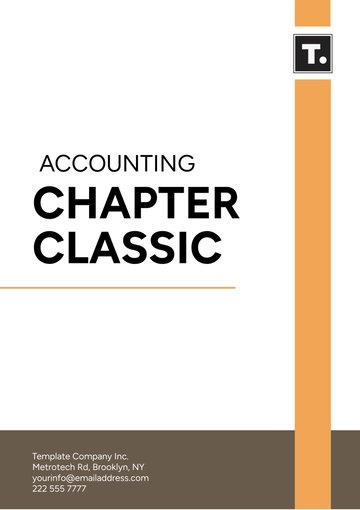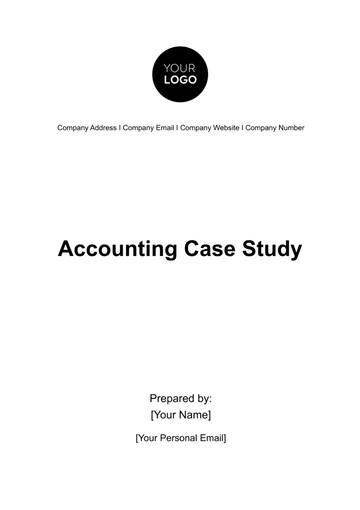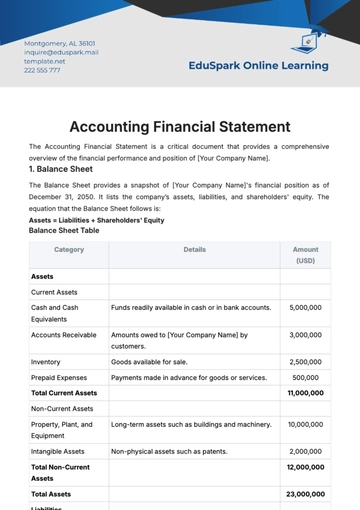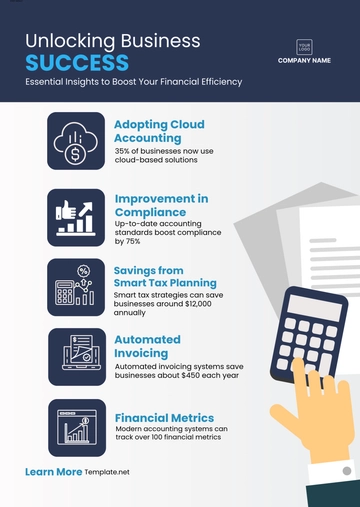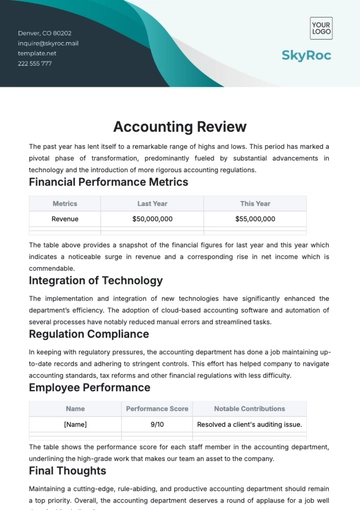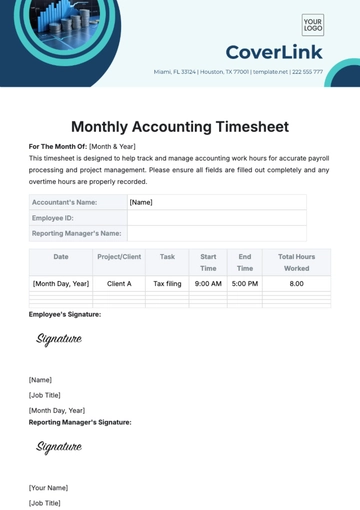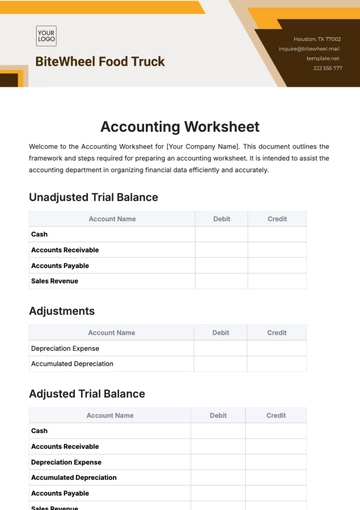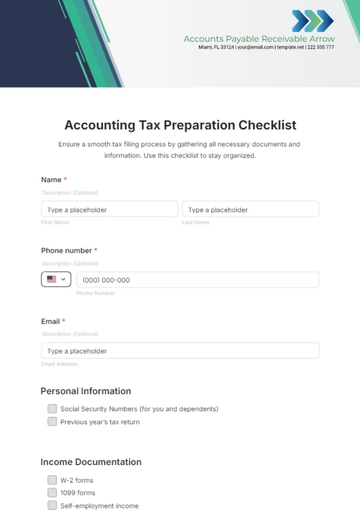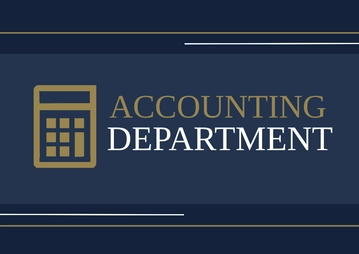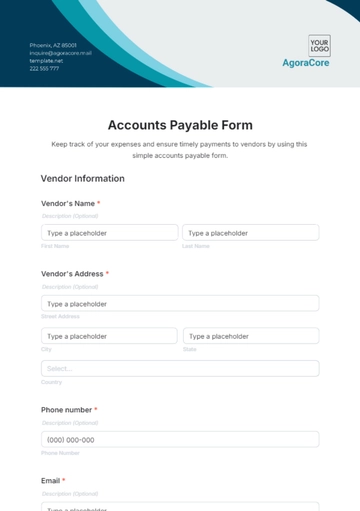Free Accounting Asset Maintenance Protocol

I. Introduction
A. Background
A pioneer in the industry, [Your Company Name] acknowledges the pivotal significance of streamlined accounting asset maintenance for sustaining operational excellence. Driven by a commitment to continuous improvement and the highest industry standards, the company has meticulously crafted this protocol. This proactive initiative underscores [Your Company Name]'s dedication to optimizing asset management processes and ensuring the longevity and reliability of its critical resources. By embracing this protocol, the company aims to fortify its position as an industry leader, setting a benchmark for efficiency and accountability in accounting asset maintenance. This protocol reflects the company's unwavering dedication to excellence and its forward-looking approach to asset management.
B. Purpose of the Protocol
Ensure Operational Continuity
The primary purpose is to ensure the seamless operational continuity of [Your Company Name] by establishing robust protocols for maintaining both financial and operational assets.
Enhance Risk Mitigation
The protocol focuses on enhancing risk mitigation strategies, identifying potential threats to asset integrity, and implementing proactive measures to safeguard against disruptions.
Ensure Regulatory Compliance
Another crucial purpose is to ensure strict adherence to regulatory requirements governing accounting asset management, fostering transparency, and maintaining the highest standards of financial integrity.
C. Scope and Applicability
Finance Department
The protocol extends its scope to the Finance Department, encompassing all activities related to financial accounting, budgeting, and reporting. This includes the maintenance of financial software, databases, and the secure handling of sensitive financial information.
Operations Division
Within the Operations Division, the protocol covers the maintenance of physical assets used in day-to-day operations, such as machinery, equipment, and facilities. It emphasizes preventive measures to ensure uninterrupted operational workflows.
IT Infrastructure Management
The protocol extends to IT Infrastructure Management, addressing the maintenance of software, hardware, and technology assets essential for accounting processes. This includes regular updates, security measures, and optimal performance monitoring.
Procurement and Supply Chain
In the realm of Procurement and Supply Chain, the protocol guides the maintenance of accurate records related to asset procurement. It ensures that the supply chain is aligned with the company's accounting asset standards and compliance requirements.
Other Relevant Departments
Any other department directly involved in the acquisition, utilization, or maintenance of accounting assets falls within the protocol's scope. This flexibility allows for adaptability to evolving organizational structures and emerging asset management needs.
II. Roles and Responsibilities
A. Accounting Asset Management Team
Identify and Classify Accounting Assets
Classifying accounting assets, considering evolving organizational needs and adhering to industry standards.
Implementing rigorous labeling and documentation processes to ensure a clear and standardized system for asset recognition and tracking.
Conduct Regular Audits and Inspections
Proactively engaging in routine audits and inspections, scrutinizing the condition and functionality of accounting assets.
Swiftly and effectively resolving any discrepancies or issues identified during audits, maintaining the integrity of the asset database.
Plan and Execute Maintenance
Collaborating seamlessly with relevant departments, actively participating in planning and executing preventive and corrective maintenance activities.
Emphasizing not just addressing issues but strategic planning to ensure assets operate at optimal levels throughout their lifecycle.
B. Finance Department Responsibilities
Maintain Financial Software
Overseeing the maintenance of financial software and databases to ensure the accuracy and reliability of financial data.
Collaborating closely with IT teams to address software-related issues promptly, minimizing disruptions to financial operations.
Handle Financial Information Securely
Implementing robust security measures to safeguard sensitive financial information from potential threats.
Conducting regular training sessions to keep staff abreast of the latest security protocols, fostering a culture of data security awareness.
C. Operations Division Responsibilities
Implement Preventive Maintenance Procedures
Going beyond reactive approaches, actively developing and implementing preventive maintenance procedures for machinery, equipment, and facilities.
Establishing a well-defined schedule for regular inspections and upkeep activities to ensure assets operate efficiently and minimize the risk of unexpected failures.
Plan for Emergency Response
Formulating contingency plans for emergency situations affecting physical assets.
Rigorously training personnel on emergency response protocols to ensure a swift and coordinated approach to minimize asset damage and downtime.
III. Asset Identification and Tagging Protocol
A. Establishing Unique Identification
Develop a Standardized Identification System
A cross-functional team, including representatives from the Finance and Operations Departments, will collaboratively design and implement a standardized system for assigning unique identifiers to all accounting assets.
The development process will occur annually to accommodate changes in asset categorizations or technological advancements.
Achieve a minimum of 95% accuracy in automated scanning and data capture.
Implement Barcode or RFID Technology
The IT and Asset Management teams will collaborate to integrate barcode or RFID technology into the identification process.
Initial implementation will be a one-time process, followed by regular assessments for technological updates.
Maintain 100% accuracy in recording acquisition date, depreciation details, and maintenance history.
Regular Audits for Identifier Integrity
Conduct monthly audits to ensure the integrity of unique identifiers.
Address and rectify any discrepancies identified during the audit process.
Maintain a record of audit findings and corrective actions.
B. Documentation and Records Management
Maintain Comprehensive Asset Records
The Finance Department will be responsible for creating and maintaining a centralized repository for detailed records of each accounting asset.
Regular updates will occur monthly, capturing changes in asset status or relevant details.
Ensure database accuracy with no overdue updates exceeding 5%.
Regularly Update Asset Database
The Asset Management team will conduct regular reviews of asset records and update the database accordingly.
Quarterly reviews with immediate updates for any changes, disposals, or acquisitions.
Achieve a minimum of 95% accuracy in automated scanning and data capture.
Periodic Internal Audits
Schedule quarterly internal audits of the asset database for accuracy and completeness.
Document audit findings and implement corrective actions as necessary.
Maintain a historical log of audit results for reference and improvement tracking.
C. Asset Tagging Procedures
Standardize Tagging Procedures
The Operations Division will oversee the physical tagging of accounting assets, following standardized protocols developed by the cross-functional team.
Tagging procedures will be conducted during asset acquisition, with immediate updates for any changes, disposals, or acquisitions.
Maintain 100% accuracy in recording acquisition date, depreciation details, and maintenance history.
Training and Compliance Checks
Conduct periodic training sessions for employees involved in the tagging process.
Regularly assess and ensure compliance with standardized tagging procedures.
Document instances of non-compliance and provide retraining as needed.
IV. Maintenance Schedule and Procedures
A. Regular Maintenance
To ensure the sustained operational excellence of [Your Company Name], a recognized industry leader, the Regular Maintenance Calendar lays out a systematic schedule for maintaining office equipment:
Asset Category | Maintenance Activity | Frequency | Responsible Department |
|---|---|---|---|
Office Equipment | Inspection and Cleaning | Quarterly | Facilities Management |
A structured calendar is crucial for sustaining asset reliability and efficiency. It prevents disruptions caused by equipment failures, extends asset lifespans, and optimizes the return on investment. The calendar above prioritizes the proactive upkeep of office equipment. The quarterly inspection and cleaning activities contribute to optimal asset conditions, minimizing the risk of unexpected breakdowns. Assigning responsibility to specialized departments also ensures accountability and expertise in executing maintenance tasks, contributing to a streamlined and effective maintenance strategy. Facilities Management, as the responsible department, showcases the importance of specialized teams overseeing maintenance activities for each asset category.
B. Preventive Maintenance Procedures
In line with the company's commitment to operational excellence, the procedures detail systematic approaches to mitigate potential issues before they impact operations:
Asset Category | Maintenance Activity | Frequency | Responsible Department |
|---|---|---|---|
Manufacturing Equipment | Lubrication and Parts Inspection | Monthly | Production Department |
The procedures prioritize preemptive measures for manufacturing equipment. Monthly lubrication and parts inspection activities are designed to enhance equipment reliability. The Production Department's role underscores the need for specialized oversight in maintaining crucial assets within their domain. By adhering to manufacturer recommendations and historical performance data, the company ensures that assets operate at optimal levels. Assigning responsibility to relevant departments aligns with the principle of expertise-driven maintenance, contributing to the overall efficiency and longevity of critical assets.
C. Reactive Maintenance Procedures
The table below outlines the details for reactive maintenance in the event of equipment breakdown:
Asset Category | Issue Description | Immediate Action | Follow-up Action |
|---|---|---|---|
IT Infrastructure | Server Failure | IT Support Team Notified | Diagnostic and Repair Process |
Quick and effective responses are crucial to minimize downtime and mitigate the impact on operations. Reactive procedures focus on swift responses to unexpected issues. In IT Infrastructure, a server failure triggers an immediate notification to the IT support team, initiating a diagnostic and repair process to address the root cause. Reacting promptly to unforeseen issues is essential to minimize disruptions. The procedures ensure a structured approach to addressing problems, emphasizing the importance of immediate action and subsequent follow-up steps. By streamlining responses, the company enhances its ability to restore normal operations efficiently, reducing the potential impact on productivity and overall business continuity.
V. Documentation and Record-Keeping Protocol
A. Asset Record Maintenance
Asset Record Maintenance is a vital aspect of the overall protocol, ensuring accurate and up-to-date information about each asset. The following diagram outlines the key steps involved in maintaining asset records:
Asset Identification
The process begins with accurately identifying each asset, assigning a unique identification code or tag. This step ensures that every asset is distinctively recognized within the system.
Data Entry and Updates
Accurate and detailed information about the asset is entered into the system. This includes essential details such as acquisition date, cost, location, and any subsequent updates or modifications. Regular updates are crucial to reflect the asset's current status.
Regular Audits and Verification
Periodic audits and verifications are conducted to cross-verify physical assets with recorded information. This step ensures alignment between the database and the actual assets, identifying discrepancies promptly.
Disposal and Decommissioning Records
When assets reach the end of their lifecycle or are decommissioned, detailed records of the disposal process are maintained. This includes the method of disposal, associated costs, and any relevant documentation.
Documentation of Maintenance History
A comprehensive history of maintenance activities is recorded. This includes details of routine maintenance, repairs, and any upgrades performed on the asset over its lifespan.
Accurate and well-maintained asset records are fundamental to effective asset management. They provide a clear overview of the asset landscape, aid in decision-making, and ensure compliance with accounting standards. By following these systematic steps, the company establishes a robust framework for maintaining accurate asset records, contributing to overall operational efficiency and financial transparency.
B. Regular Database Reviews and Updates
Accuracy Benchmark
Maintain a benchmark of at least 95% accuracy in database entries during quarterly reviews.
Identify and rectify any discrepancies found, ensuring real-time updates to the database.
Implement a continuous improvement process to address recurring issues and enhance accuracy.
Historical Log Maintenance
Maintain a historical log of all database review results and corrective actions taken.
Document instances of database inaccuracies, their root causes, and the steps taken to prevent recurrence.
Use the historical log as a reference for training and improvement initiatives.
C. Internal Audits for Documentation Integrity
Quarterly Internal Audits
Schedule quarterly internal audits of the asset documentation and record-keeping processes.
Internal auditors will assess the integrity, completeness, and accuracy of asset records.
Document and communicate audit findings to the relevant departments for corrective action.
Corrective Action Implementation
Implement corrective actions based on audit findings to address any gaps or deficiencies.
Collaborate with relevant departments to ensure timely and effective resolution.
Maintain a comprehensive log of corrective actions and their outcomes.
Continuous Improvement Measures
Use the findings from internal audits as inputs for continuous improvement initiatives.
Identify trends or recurring issues in documentation integrity and implement preventive measures.
Foster a culture of continuous improvement to enhance overall documentation processes.
VI. Asset Lifecycle Management Protocol
A. Monitoring Asset Lifespan
The table below showcases the expected lifespan of the assets:
Asset ID | Asset Type | Acquisition Date | Expected Lifespan | Current Status |
|---|---|---|---|---|
001 | Computer | 01/15/2055 | 5 years | In Use |
Monitoring the lifespan of assets is crucial for strategic decision-making. Identifying assets approaching the end of their expected lifespan allows for proactive planning, reducing the risk of unexpected failures. This, in turn, ensures operational continuity, cost-effectiveness, and optimal resource allocation. Additionally, by systematically tracking asset lifecycles, the company can implement sustainable practices, aligning with responsible asset management principles and minimizing environmental impact. Asset (ID: 001) – a computer acquired on January 15, 2055 has an expected lifespan of 5 years and is currently in use. Monitoring details allows for proactive management of assets nearing the end of their lifespan, enabling timely decisions on replacement or maintenance to avoid disruptions.
B. Preventive Maintenance Plans
Asset-specific Preventive Measures
Develop customized preventive maintenance plans for each category of accounting asset. Tailor measures to address specific vulnerabilities and extend asset lifespan. Implementing asset-specific plans ensures a targeted approach to maintenance, optimizing resource allocation.
Scheduled Maintenance Calendar
Establish a yearly maintenance calendar outlining scheduled preventive measures for all accounting assets. Communicate the calendar company-wide for awareness. Adherence to the scheduled maintenance calendar reduces unexpected disruptions and enhances overall asset reliability.
Vendor Collaboration for Preventive Measures
Collaborate with vendors to incorporate their recommendations into preventive maintenance plans. Regular consultations with vendors ensure alignment with industry best practices. Vendor collaboration enhances the effectiveness of preventive measures, leveraging external expertise.
C. Asset Repairs and Replacements
Prompt Response to Asset Failures
Institute a 24-hour response protocol for addressing asset failures reported by teams. Immediate response minimizes downtime and prevents potential cascading effects. Swift repairs contribute to maintaining optimal operational efficiency.
Replacement Criteria and Timelines
Establish replacement timelines based on asset depreciation and industry benchmarks. Transparent communication of replacement criteria ensures strategic decision-making in asset management.
Asset Replacement Budgeting
Integrate asset replacement budgeting into annual financial planning. Allocate funds for potential replacements based on the lifecycle analysis of accounting assets. Proactive budgeting ensures financial preparedness and minimizes the impact of unexpected replacements.
D. End-of-Life Asset Disposal
Ethical and Sustainable Disposal Practices
Adhere to ethical and environmentally sustainable disposal practices for accounting assets reaching the end of their lifecycle. Compliance with regulatory standards and industry best practices demonstrates corporate responsibility. Implementing sustainable disposal practices aligns with broader environmental initiatives.
Data Security Protocols
Prioritize data security during the disposal of assets with sensitive information. Collaborate with the IT department to ensure secure data wiping or destruction. Stringent data security protocols prevent potential breaches during asset disposal.
Documentation of Disposal Processes
Maintain detailed documentation of the entire asset disposal process, including methods used and final destinations. Regular audits of disposal documentation ensure compliance with environmental regulations. Transparent reporting enhances accountability and fosters trust with stakeholders.
E. Continuous Improvement Strategies
Feedback Mechanisms for Asset Users
Regular surveys and feedback sessions enable continuous improvement. Responding promptly to user feedback enhances asset usability and satisfaction.
Benchmarking Against Industry Best Practices
Conduct bi-annual benchmarking against industry best practices in asset maintenance. Implement improvements based on benchmarking results to stay at the forefront of asset management standards. Benchmarking ensures continuous alignment with evolving industry norms.
Cross-Departmental Collaboration for Improvement
Facilitate cross-departmental collaboration to identify improvement opportunities in asset maintenance. Regular meetings and collaborative initiatives enhance communication between departments. A culture of continuous improvement fosters innovation and efficiency in asset management.
VII. Compliance and Regulations
A. Adherence to Accounting Standards
This table outlines the key details related to adherence, ensuring a systematic approach to accounting for all relevant assets:
Accounting Standard | Applicability | Frequency of Audit | Responsible Department |
|---|---|---|---|
FASB ASC 360-10-35 | All Accounting Assets | Annually | Finance and Accounting |
In the pursuit of financial transparency and accuracy, the company diligently follows FASB ASC 360-10-35, specifically addressing property, plant, and equipment. An annual audit frequency guarantees ongoing compliance, with the Finance and Accounting department taking charge. This proactive approach aligns with industry best practices, providing a clear framework for asset valuation and reporting.
Strict adherence to accounting standards is paramount for transparent financial reporting. Following these standards establishes consistency in asset valuation, enabling accurate financial assessments. The Finance and Accounting department's role in regular audits ensures that the company's financial records align with industry standards. This commitment to adherence not only enhances the company's financial credibility but also fosters trust among stakeholders, including investors, regulatory bodies, and partners.
B. Compliance with Environmental Regulations
The table below provides insights into the systematic assessments and reporting mechanisms, overseen by the Environmental Health and Safety department:
Regulation | Environmental Impact Assessment | Compliance Reporting | Responsible Department |
|---|---|---|---|
EPA Regulations | Periodic assessments | Quarterly | Environmental Health and Safety |
Ensuring compliance with environmental regulations is a strategic imperative for responsible corporate citizenship. To uphold environmental responsibility, the company meticulously complies with EPA regulations governing the environmental impact of accounting asset management. Quarterly compliance reporting ensures timely updates. The Environmental Health and Safety department oversees these assessments, promoting a proactive stance in minimizing the ecological footprint associated with accounting asset activities. This commitment not only safeguards the environment but also aligns with societal expectations, contributing to the company's reputation as a socially responsible entity.
Appendices
Asset Maintenance Checklist
A comprehensive checklist outlining essential steps for routine asset maintenance.
Equipment Calibration Schedule
A schedule providing guidelines for the calibration of critical equipment to ensure optimal performance.
Training Records
A log for maintaining records of employee training related to asset maintenance procedures and safety protocols.
- 100% Customizable, free editor
- Access 1 Million+ Templates, photo’s & graphics
- Download or share as a template
- Click and replace photos, graphics, text, backgrounds
- Resize, crop, AI write & more
- Access advanced editor
Standardize asset maintenance protocols effortlessly with our customizable Accounting Asset Maintenance Protocol Template, available only on Template.net! This editable protocol ensures consistent and efficient asset maintenance. Edit easily with the advanced AI Editor Tool, aligning the protocol with your organizational needs. Streamline asset maintenance processes and personalized workflows right away!





